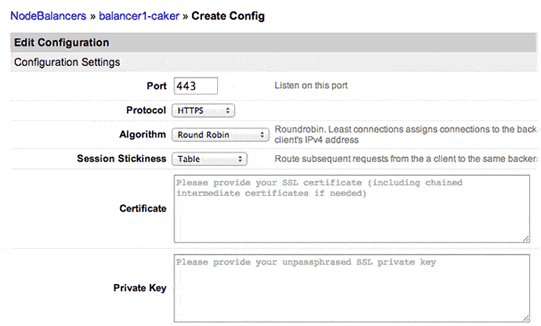Los NodeBalancers siempre han soportado protocolos basados en TCP, incluyendo SSL - pero nos complace anunciar que los NodeBalancers ahora incluyen soporte nativo para HTTPS.
Esto significa que un NodeBalancer puede terminar las conexiones SSL por usted, y tener la funcionalidad y el comportamiento que ya disfruta del modo HTTP - incluyendo la configuración correcta de un X-Fowarded-For con la dirección IP del solicitante, y las cookies de sesión para la adherencia del nodo backend.
Para ello, cree un nuevo perfil de configuración utilizando el puerto 443 (normalmente), establezca el Protocolo a HTTPS y, a continuación, proporcione el certificado y su clave privada (sin frase de contraseña). También se admiten certificados intermedios encadenados. Aquí hay una captura de pantalla que muestra las nuevas opciones:

Una nota para los sitios SSL con mayor tráfico: la negociación SSL es una operación computacionalmente costosa, y la capacidad de un NodeBalancer en modo SSL puede no ser suficiente. En estas situaciones recomendamos utilizar el modo TCP y distribuir la carga de terminación de SSL a sus Linodes backend. Como alternativa, puede utilizar varios NodeBalancers en modo SSL y utilizar DNS round-robin.
Más información:
Que lo disfrutes.







Comentarios (10)
Does Linode use HAProxy to run this service?
Hi,
If not good for high traffic, what’s the advantage ?
Thanks
@Jan: convenience – it’s very easy to get SSL working using the NodeBalancer user interface. This is also a good first step for us supporting native SSL — we gotta start somewhere.
How computationally expensive is SSL for you guys?
From Google: “On our production frontend machines, SSL/TLS accounts for less than 1% of the CPU load, less than 10KB of memory per connection and less than 2% of network overhead.” (https://www.imperialviolet.org/2010/06/25/overclocking-ssl.html)
What kind of maximum concurrency are we talking about here for SSL on a nodebalancer?
What traffic max rate is expected to be handled by these balancers? If a regular balancer handles 10k, what about SSL ones?
NodeBalancers have a 10,000 concurrent connection limit. It’s not a request/sec limit. There is no artificial request/sec limit built into NodeBalancers. A NodeBalancer config in TCP or HTTP mode can accept connections pretty much as fast as packets can be slung to/from the backends. In other words: it’s a lot.
A NodeBalancer config in HTTPS mode can achieve 10,000 concurrent connections, too – it may just take some time to ramp up to that. While testing very small requests (connections don’t live long) we’ve seen about 150 req/sec via HTTPS mode. Again, it’s a good place to start, and we’ll be working on improving the req/sec throughput of native HTTPS mode.
Thanks for the comments 🙂
Hi. I previously asked if Linode uses HAProxy for this service? (And indirectly I guess I was wondering what other software/hardware is being use. My post is still awaiting moderation even though posts made after mine have been approved.
In the past Linode has been quite open about its architecture, especially about its implementation of Xen. Is there a reason we don’t get much detail about how NodeBalancers work? Is there something offensive or inappropriate about me asking these things?
Tom, I’d be interested too… Although it’s not out of the realm of possibility that they built their own with something like Golang (esp since 1.1), an accounting proxy would be trivial on such stack.
Any chance to have TLS renegotiation so we can host more than one domain on HTTPS ?